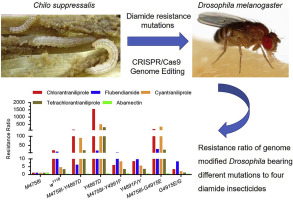当前位置:
X-MOL 学术
›
Insect Biochem. Mol. Biol.
›
论文详情
Our official English website, www.x-mol.net, welcomes your
feedback! (Note: you will need to create a separate account there.)
Multiple target-site mutations occurring in lepidopterans confer resistance to diamide insecticides.
Insect Biochemistry and Molecular Biology ( IF 3.2 ) Pub Date : 2020-03-31 , DOI: 10.1016/j.ibmb.2020.103367 Jing-Mei Huang 黄镜梅 1 , Cong Rao 饶聪 1 , Shuai Wang 王帅 1 , Lin-Feng He 何林凤 1 , Si-Qi Zhao 赵思琪 1 , Li-Qi Zhou 周丽琪 1 , Yun-Xia Zhao 赵云霞 1 , Feng-Xia Yang 杨凤霞 1 , Cong-Fen Gao 高聪芬 1 , Shun-Fan Wu 吴顺凡 1
Insect Biochemistry and Molecular Biology ( IF 3.2 ) Pub Date : 2020-03-31 , DOI: 10.1016/j.ibmb.2020.103367 Jing-Mei Huang 黄镜梅 1 , Cong Rao 饶聪 1 , Shuai Wang 王帅 1 , Lin-Feng He 何林凤 1 , Si-Qi Zhao 赵思琪 1 , Li-Qi Zhou 周丽琪 1 , Yun-Xia Zhao 赵云霞 1 , Feng-Xia Yang 杨凤霞 1 , Cong-Fen Gao 高聪芬 1 , Shun-Fan Wu 吴顺凡 1
Affiliation

|
Diamide resistant phenotypes have evolved in the field and the resistance has been attributed to target-site mutations in some lepidopteran pests. In this study, we documented the resistance status of Chilo suppressalis to chlorantraniliprole during 2016-2018 in seven provinces of China. To investigate the possible role of target-site mutations as known from lepidopterans, we sequenced respective domains of the RyR gene of C. suppressalis with different levels of diamide resistance. The results revealed that I4758M (corresponding to I4790M in P. xylostella), Y4667D/C (numbered according to C. suppressalis), G4915E (corresponding to G4946E in P. xylostella), and one novel Y4891F (numbered according to C. suppressalis) RyR target-site mutations were present. The contribution of these mutations was further investigated by diamide toxicity bioassays with eight genome modified Drosophila melanogaster lines. The study showed that genome modified flies bearing the Y4667D mutation (corresponding to the Y4667D and I4758M simultaneous mutation in C. suppressalis) exhibited high resistance ratios to chlorantraniliprole (1542.8-fold), cyantraniliprole (487.9-fold) and tetrachlorantraniliprole (290.1-fold). The M4758I and G4915E simultaneous mutations (corresponding to single G4915E mutation in C. suppressalis) showed high resistance ratios to chlorantraniliprole (153.1-fold) and cyantraniliprole (323.5-fold), and relatively low resistance to flubendiamide (28.9-fold) and tetrachlorantraniliprole (25.2-fold). These findings suggest that multiple point mutations in RyR confer diamide resistance of C. suppressalis. The results contribute to a better understanding of insect diamide resistance mechanisms and provide insights on the impact of RyR target-site mutations in insects.
更新日期:2020-03-31









































 京公网安备 11010802027423号
京公网安备 11010802027423号